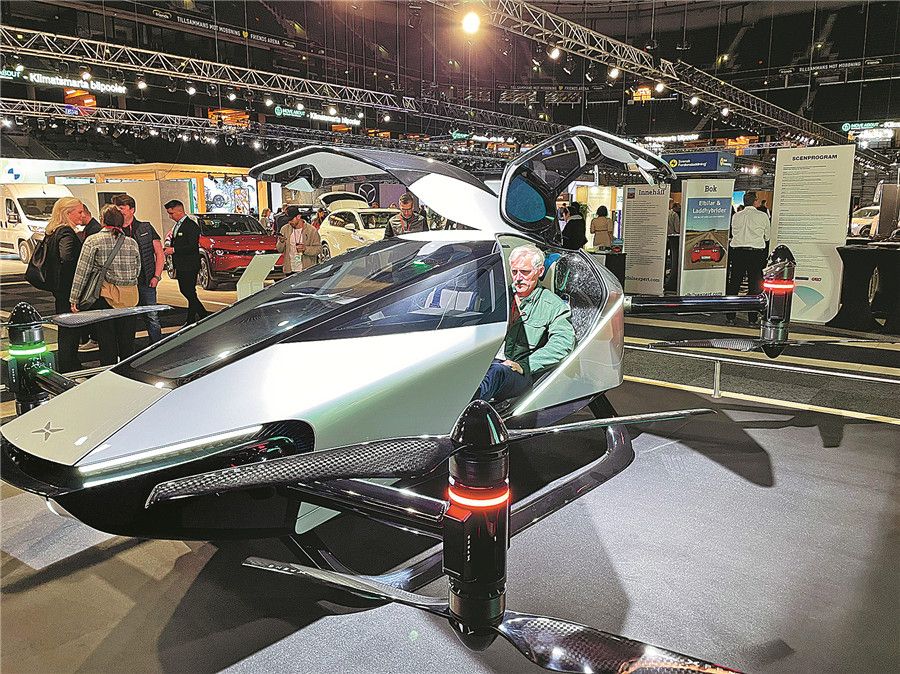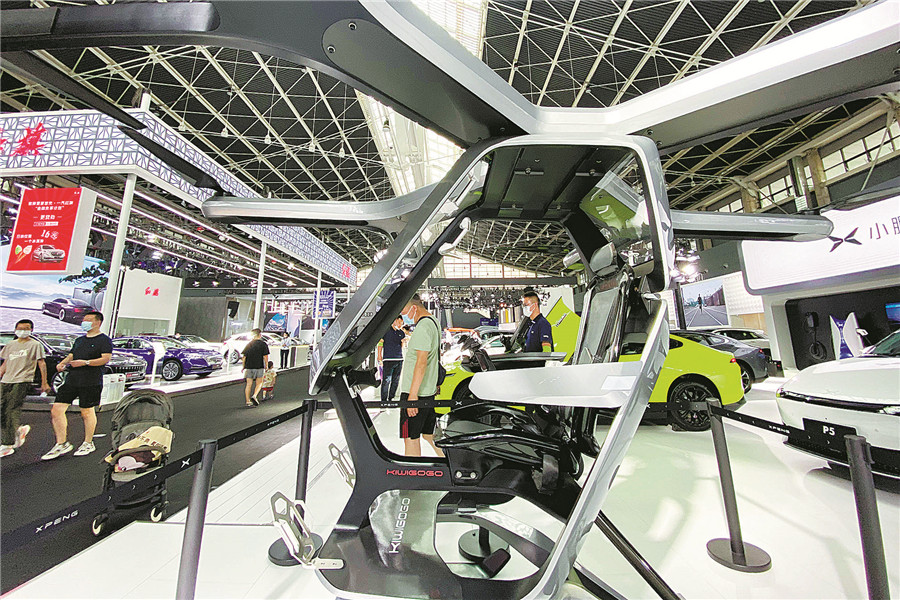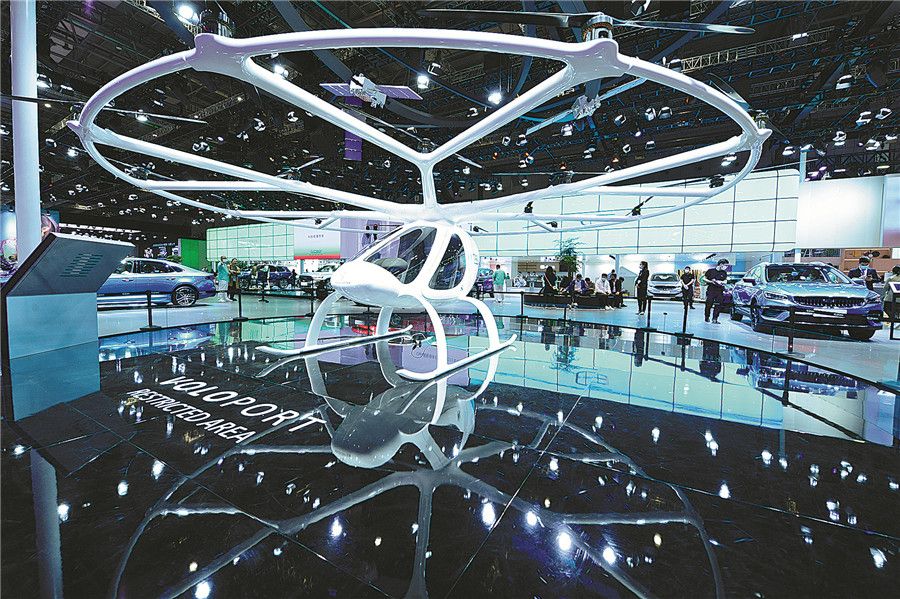
A visitor to an auto show in Stockholm, Sweden, in April tries a flying car made by Xpeng Aeroht. (Photo by Xinhua)
High hopes voiced for emerging flying cars sector
Drivers caught in traffic jams may often wish they could take to the air to bypass busy roads, before landing in areas free from congestion. That wish is now one step closer to becoming reality.
Late last month, Chinese company Xpeng Aeroht unveiled a flying car prototype that resembles a typical car except for a foldaway eight-motor system mounted on the top that enables it to fly.
Named by the company as the X3, it is the world's first electric vertical takeoff and landing vehicle, or eVTOL, that can be driven on roads and take off to cruise over traffic jams before landing and continuing its journey.
In driving mode, the X3 is comparable with conventional cars in terms of functionality and dimensions, according to the manufacturer.
In flight, it is piloted by using a steering wheel and right-hand gear lever to move forward and reverse, make turns, ascend, hover, and descend. It is equipped with a dual-engine backup system to ensure safety.

Flying vehicles are displayed at an auto show in Shijiazhuang, Hebei province, in June. (Photo by Xinhua)
A promotional video shows the 2-metric-ton vehicle taking off and hovering 10 meters above the ground for 30 seconds, before landing safely.
Compared with its predecessor, which was released last year, this latest version more closely resembles the model the company hopes to put into production.
Xpeng Aeroht, which has not released a production schedule, said the new flying car successfully completed its maiden flight and a number of single-motor failure tests.
"Subject to laws and regulations for low-altitude airspace, the car can take off and land vertically, and fly over traffic congestion, obstacles and rivers to meet a host of short-distance mobility needs," the company said in a statement.
An affiliate of Xpeng, a Chinese electric car startup that is a rival to Tesla, Xpeng Aeroht is Asia's largest company manufacturing flying cars. Its 700-plus employees — more than 85 percent of them engineers — are working on developing next-generation products. The company said it would have more than 1,000 employees by the end of this year.
The latest X3 prototype was unveiled days after the company tested a flying vehicle, the X2, in the United Arab Emirates — the first public overseas flight for the model, which made its global debut in Shanghai in July last year.
Brian Gu, vice-chairman and president of Xpeng, said the company has reached a significant milestone, describing it as "a major step in Xpeng's exploration of future mobility".
The two-seater X2 weighs 560 kilograms and is designed to be used at low altitude. It can fly for up to 35 minutes, with a maximum speed when airborne of 130 kilometers per hour. The car can be used manually or automatically, but unlike the X3, it is not suitable for road use.
Xpeng Aeroht said, "The car will be suitable for future low-altitude city flights and is perfect for short-distance city journeys such as sightseeing and medical transportation."
The X2 looks like models being developed by most companies manufacturing flying cars. According to a report by consultants McKinsey, more than 250 companies worldwide are developing and producing such vehicles, and the list is growing.
Although they are called flying cars or air taxis, these vehicles usually don't have wheels. They feature wings, or wings and rotors, fly at speeds of 100 to 300 km/h and can carry several passengers.
Powered by batteries, they have less complicated parts than ordinary vehicles, and are safer than light aircraft such as helicopters. They are also quieter and are expected to be cheaper.
The vehicles are aimed at offering quick point-to-point services for urban commuters and those in urgent need of medical help.

The Volo 2X, launched by Zhejiang Geely Holding Group and German company Volocopter, debuts at the 19th Shanghai International Auto Show last year. (Photo by China Daily)
Prototype unveiled
In addition to Xpeng Aeroht, Alef Aeronautics, a United States startup based in Silicon Valley, California, is exploring the possibility of launching flying cars.
As the company unveiled its Model A prototype last month, its CEO Jim Dukhovny told journalists, "A flying car has to be a car, which means it can drive on a regular street and park in a regular parking space.
"It also should have vertical takeoff. If you require an airport for takeoff, what problem are you solving? And why is this a flying car?"
The electric Model A — the size of a large sedan — has four wheels, and its mesh-covered body conceals eight propellers, which allow it to take off vertically.
Once airborne, it tilts 90 degrees so that the top of the car faces forward, before proceeding to fly at speeds of up to 56 km/h.
The model has a driving range of 322 km and a flight range of 160 km. Dukhovny said the car will cost $300,000, and production and initial deliveries could start in 2025. The startup is taking orders on its website for the first models.
In addition to startups, many established carmakers are exploring opportunities in the promising sector, but most of them are working on conventional flying cars — those that cannot be driven on the ground.
In July, Volkswagen Group China unveiled its first such attempt. This model, which has an x-wing configuration 11.2 meters long and 10.6 m wide, is powered by eight rotors for vertical lift and two propellers for horizontal flight.
The company said the car — based on current autonomous driving solutions and battery technology — is part of its strategy to explore and break new ground in fully electric and sustainable individual mobility concepts.
It will conduct several test flights before the end of this year to optimize the concept, and an improved prototype will undergo further advanced test flights in late summer next year.
In the future, this fully electric and automated eVTOL could carry four passengers and luggage for up to 200 km, the company said.
Volkswagen Group China added that the vehicle is likely to be pitched initially as a premium product for high net worth and tech-savvy Chinese customers using VIP air shuttle services, for example.
In China, the vehicle is set to play a significant role in transportation between congested megacities, the company said.
The carmaker launched the vertical mobility project, which includes developing the urban air mobility market and taking urban traffic into airspace, in 2020.
Zhejiang Geely Holding Group, which owns Volvo, was one of the first carmakers to enter the flying vehicle sector.
Last year, it teamed up with German company Volocopter, which specializes in making autonomous air vehicles, to establish a joint venture in Chengdu, capital of Sichuan province, which will oversee production and market operations for Volocopter products in China.
The joint venture, which plans to help promote urban air mobility in China over the next three to five years, has signed orders with Volocopter for 150 aircraft, including unmanned logistical aerial vehicles and manned aircraft.
Heavy investment
South Korean carmaker Hyundai is also investing heavily in the emerging industry. In November last year, it launched Supernal, a subsidiary focusing on the so-called advanced air mobility market.
Supernal said it plans to operate its first commercial flight in 2028 and scale its operations as the market and public acceptance for such vehicles begin to grow in the 2030s.
Its first aerial vehicle will be electric-powered, with an autonomous capability, and is planned to accommodate four to five passengers initially on routes in urban and suburban areas.
Ben Diachun, Hyundai's chief technology officer, said, "We're developing a commercially viable advanced air mobility product from the start, designing and manufacturing our vehicle to the highest safety, noise, efficiency, and affordability standards."
In July, Supernal unveiled its eVTOL vehicle cabin concept, providing a glimpse of the passenger compartment in its upcoming intracity air shuttle.
This model has five seats and a lightweight structure made from forged carbon fiber. Each ergonomically contoured seat features a control center based on the design for consoles found in traditional cars.
There is a charging port and small storage compartment for individual passengers. The overhead lights mimic a car's sunroof, while adjusting during different phases of flight.
Supernal said it is certifying the eVTOL for commercial use in the US, starting in 2028, and plans to launch the flying vehicle in Europe soon afterward.
It will be just one electric air vehicle in a "family" planned by Hyundai, which is busy creating a hydrogen-powered, mid-sized flying vehicle for inter-city cargo and passenger shuttle services.
Last year, General Motors, or GM, unveiled a flying car that featured a 90-kilowatt motor powering an ultra-lightweight body with four pairs of rotors.
This autonomous single-passenger model can travel at speeds of up to 90 km/h, the carmaker said. However, it added that flying taxi services will not be in commercial use until 2030, as the sector needs to overcome regulatory and technical hurdles.
Pamela Fletcher, former vice-president of GM's global innovation team and now chief sustainability officer at Delta Air Lines, said: "It's a very nascent space. There's a lot of work to be done on the regulatory side, as well as the technology side."
She is not exaggerating. To date, no eVTOLs worldwide have been granted type certificates, which show that aviation authorities have accepted an aircraft's design.
After this process, which may take years and millions of dollars to complete, other credentials are required, such as airworthiness certificates, before the vehicles can take to the air.
Gary Gysin, CEO of flying car designer and producer Wisk, which is based in the US, said the sector lacks regulations.
"Globally, we're finding that many countries are still figuring out what eVTOLs and urban air mobility regulations look like," he said.
Analysts said flying cars are first likely to take to the air commercially in the US and European countries, where the general aviation industry is well developed. General aviation refers to civil aircraft operations, with the exception of commercial airlines.
Statistics show that more than 200,000 general aviation aircraft, including helicopters and private jets, were operating in the US by the end of 2020, and about 136,000 in Europe.
China is gradually opening up its lower-altitude airspace for civilian use, and is thus a market with big potential for flying cars.
According to a medium- to long-term blueprint, China will step up research and development of flying cars, calling for breakthroughs in the integration of such cars and traditional vehicles, as well as a seamless transition between flying and road driving.
Wang Yanan, chief editor of Aerospace Knowledge magazine, said the large-scale use of flying cars will take at least 10 to 15 years, adding that a feasible way to achieve this is to introduce these cars stage by stage, initially in less-populated areas.
Yet the emerging flying vehicle sector is gradually being viewed as a serious solution to urban traffic congestion and a new alternative to personal mobility in cities.
The sector is expected to grow into a market valued at $1 trillion by 2040 and $9 trillion by 2050, according to global financial services company Morgan Stanley.
Global consultancy Roland Berger estimates that up to 160,000 flying vehicles will be operating as air taxis by 2050.
Editor: Li Wenpei






